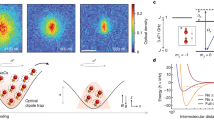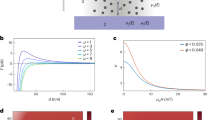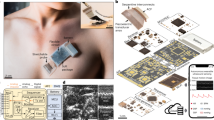Abstract
SEVERAL years ago it was found by one of us, together with P. Mariens1 and L. Thys2, that the experimental values found for the ultrasonic absorption coefficient is much larger than the theoretical value computed by means of the equation of Kirchhoff–Stokes (viscosity and heat conductivity). This deviation was explained as due to the lag in the establishment of equilibrium between the rotational and the translational energy. Since these measurements were made, new and more accurate measurements have been carried out by one of us together with R. Vermaelen3, and also on heavy hydrogen. All those determinations were made by means of an acoustical interferometer, in which different quartz crystals and different resonator tubes were used. Later, the existence of this relaxation for the rotational energy was proved by dispersion measurements, respectively by E. S. Stewart, J. L. Stewart and J. C. Hubbard4. On the other hand, the absorption coefficients found by the use of the acoustical interferometer have been criticized by P. E. Krasnooshkin5 and more recently by J. F. W. Bell6. Their argument is that an excess of absorption should be caused by the non-uniform vibration of the crystal surface, which produces excitation of the transverse modes of resonance in the interferometer tube. This excess of absorption can be determined by plotting the observed absorption coefficient αobs as a function of the pressure p, whereby  (α0 is absorption coefficient corresponding to atmospheric pressure p0, and α1 is the parasite absorption coefficient). In order to check this theory, we have carried out a series of very accurate measurements (frequency = 500.0 kc./s.) as a function of pressure and temperature (liquid oxygen temperatures) in normal- and para-hydrogen and helium gas.
(α0 is absorption coefficient corresponding to atmospheric pressure p0, and α1 is the parasite absorption coefficient). In order to check this theory, we have carried out a series of very accurate measurements (frequency = 500.0 kc./s.) as a function of pressure and temperature (liquid oxygen temperatures) in normal- and para-hydrogen and helium gas.
This is a preview of subscription content, access via your institution
Access options
Subscribe to this journal
Receive 51 print issues and online access
$199.00 per year
only $3.90 per issue
Buy this article
- Purchase on Springer Link
- Instant access to full article PDF
Prices may be subject to local taxes which are calculated during checkout
Similar content being viewed by others
References
Van Itterbeek, A., and Mariens, P., Physica, 4, 609 (1937).
Van Itterbeek, A., and Thys, L., Physica, 5, 889 (1938).
Van Itterbeek, A., and Vermaelen, R., Physica, 9, 345 (1942).
Stewart, E. S., Phys. Rev., 68, 231 (1945). Stewart, J. L., and Stewart, E. S., J. Acous. Soc. Amer., 20, 585 (1948). Stewart, E. S., Stewart, J. L., and Hubbard, J. C., Phys. Rev., 68, 231 (1945).
Krasnooshkin, P. E., Phys. Rev., 65, 190 (1944).
Bell, J. F. W., Proc. Phys. Soc., B, 63, 958 (1950).
Author information
Authors and Affiliations
Rights and permissions
About this article
Cite this article
VAN ITTERBEEK, A., VERHAEGEN, L. Ultrasonic Absorption in Normal- and Para-Hydrogen. Nature 167, 477–478 (1951). https://doi.org/10.1038/167477a0
Issue Date:
DOI: https://doi.org/10.1038/167477a0
This article is cited by
-
Real-time hydrogen molecular dynamics satisfying the nuclear spin statistics of a quantum rotor
Communications Chemistry (2022)
-
Velocità e assorbimento di ultrasuoni nei gas
Il Nuovo Cimento (1952)
Comments
By submitting a comment you agree to abide by our Terms and Community Guidelines. If you find something abusive or that does not comply with our terms or guidelines please flag it as inappropriate.



